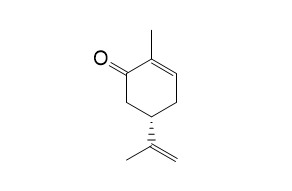(+)-Carvone
(S)-(+)-Carvone appears to have anticonvulsant-like activity.
Inquire / Order:
manager@chemfaces.com
Technical Inquiries:
service@chemfaces.com
Tel:
+86-27-84237783
Fax:
+86-27-84254680
Address:
1 Building, No. 83, CheCheng Rd., Wuhan Economic and Technological Development Zone, Wuhan, Hubei 430056, PRC
Providing storage is as stated on the product vial and the vial is kept tightly sealed, the product can be stored for up to
24 months(2-8C).
Wherever possible, you should prepare and use solutions on the same day. However, if you need to make up stock solutions in advance, we recommend that you store the solution as aliquots in tightly sealed vials at -20C. Generally, these will be useable for up to two weeks. Before use, and prior to opening the vial we recommend that you allow your product to equilibrate to room temperature for at least 1 hour.
Need more advice on solubility, usage and handling? Please email to: service@chemfaces.com
The packaging of the product may have turned upside down during transportation, resulting in the natural compounds adhering to the neck or cap of the vial. take the vial out of its packaging and gently shake to let the compounds fall to the bottom of the vial. for liquid products, centrifuge at 200-500 RPM to gather the liquid at the bottom of the vial. try to avoid loss or contamination during handling.
Molecules.2024, 29(5):1171.
Front Nutr.2023, 10:1168095.
Food Structure2023, 36:100324.
Natural Product Res.&Deve.2022, 1001-6880.
Front Microbiol.2023, 14:1232039.
Applied Biological Chemistry2022, 65(77).
Antibiotics (Basel).2024, 14(1):8.
Metabolites. 2023, 13(11):1122.
Pharmaceuticals (Basel).2021, 14(6):588.
Advances in Traditional Medicine 2021, 21:779-789.
Related and Featured Products
Chirality, 2010, 19(4):264-268.
Influence of the chirality of (R)-(-)- and (S)-(+)-carvone in the central nervous system: a comparative study.[Pubmed:
17299731]
Many terpenes are used therapeutically, and as flavor and fragrance materials. (R)-(-)-Carvone, the main constituent of spearmint oil, and (S)-(+)-Carvone, found as major component of caraway and dill seed oils, have several applications and are used in cosmetic, food, and pharmaceutical preparations.
METHODS AND RESULTS:
In this study, the effect of enantiomers of carvone on the central nervous system (CNS) was evaluated in mice. The LD50 value was 484.2 mg/kg (358.9-653.2) for (S)-(+)-Carvone, and 426.6 (389.0-478.6) mg/kg for (R)-(-)-carvone. Both enantiomers caused depressant effects, such as decrease in the response to the touch and ambulation, increase in sedation, palpebral ptosis, and antinociceptive effects. (S)-(+)- and (R)-(-)-carvone caused a significant decrease in ambulation. (R)-(-)-Carvone appeared to be more effective than its corresponding enantiomer at 0.5 and 2.0 h after administration. However, (S)-(+)-Carvone was slightly more potent at 1 h. In potentiating pentobarbital sleeping time, (R)-(-)-carvone was more effective than (S)-(+)-Carvone at 100 mg/kg, but was less potent at 200 mg/kg compared to the (+)-enantiomer, indicating a sedative action. (S)-(+)-Carvone at the dose of 200 mg/kg increased significantly the latency of convulsions induced by PTZ and PIC, but (R)-(-)-carvone was not effective against these convulsions.
CONCLUSIONS:
These results suggest that (S)-(+)-Carvone and (R)-(-)-carvone have depressant effect in the CNS. (S)-(+)-Carvone appears to have anticonvulsant-like activity.



